Italian pasta is a cultural icon, celebrated for its diverse shapes, regional specialties, and versatility in pairing with sauces. A timeless symbol of Italian cuisine, it combines tradition and innovation, offering endless possibilities for culinary exploration and enjoyment.
Cultural Significance of Pasta in Italy
Pasta is a cornerstone of Italian identity, embodying the nation’s rich culinary heritage. It unites people across regions, with countless shapes and sauces reflecting local traditions. From family gatherings to festive celebrations, pasta symbolizes warmth, simplicity, and togetherness. Its enduring popularity highlights Italy’s passion for authentic, nourishing food that transcends generations and cultures, making it a beloved symbol of Italian life and tradition.
Overview of Pasta Varieties
Italian pasta offers incredible diversity, with over 400 documented shapes, each designed for specific sauces. From delicate strands like spaghetti to sturdy tubes such as penne, pasta varieties cater to diverse culinary needs. Dried and fresh pastas differ in texture and preparation, while regional specialties add unique flavors. This versatility ensures pasta remains a staple, adaptable to countless dishes and preferences, making it a cornerstone of Italian cuisine and global kitchens alike.
Types of Italian Pasta
Italian pasta is categorized into dried (pasta secca) and fresh (pasta fresca), each offering distinct textures and flavors. These varieties are further enriched by regional specialties, creating a diverse culinary canvas for sauces and traditions.
Dried Pasta (Pasta Secca)
Dried pasta, known as pasta secca, is a cornerstone of Italian cuisine, made from durum wheat semolina. Its long shelf life makes it versatile and accessible worldwide. Produced through extrusion and drying, it retains a firm texture, pairing perfectly with hearty sauces. Popular shapes like spaghetti, penne, and rigatoni are staples in countless dishes, showcasing its adaptability and enduring appeal in both traditional and modern recipes.
Fresh Pasta (Pasta Fresca)
Fresh pasta, or pasta fresca, is crafted with eggs and flour, offering a delicate texture and richer flavor. Typically produced regionally, it is enjoyed in dishes like tagliatelle and ravioli. Its higher moisture content makes it ideal for creamy sauces, showcasing Italy’s culinary craftsmanship and regional diversity in pasta-making traditions.
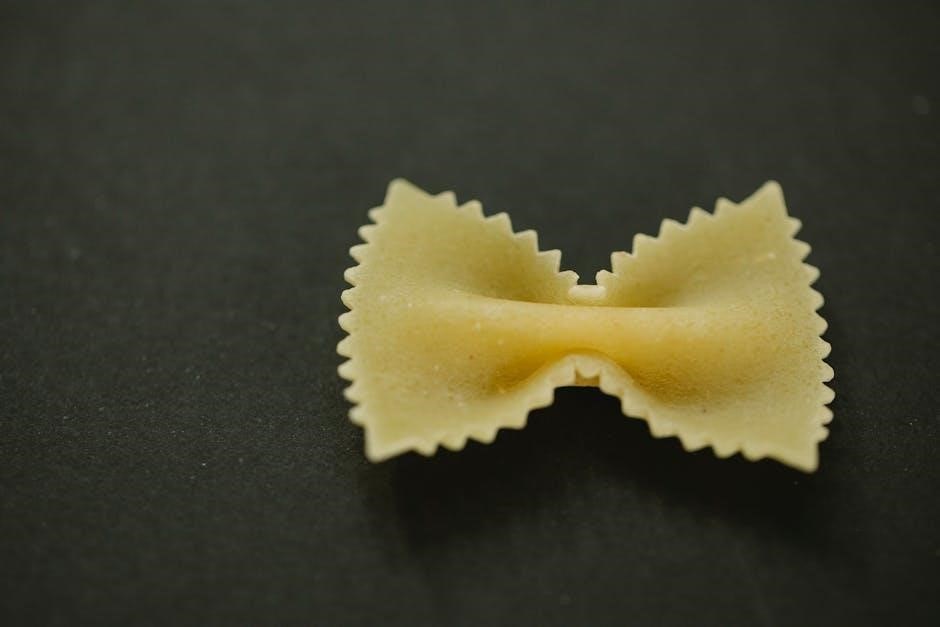
Popular Pasta Shapes
From spaghetti and linguine to rigatoni and ravioli, Italy offers countless pasta shapes, each designed for specific sauces, ensuring a perfect culinary match every time.
Short Pasta Shapes
Short pasta shapes, like rigatoni, penne, and farfalle, are perfect for hearty, chunky sauces. Rigatoni’s tubular shape holds onto robust tomato or meat ragù, while penne’s angled ends trap creamy sauces. Farfalle, with its bowtie form, pairs well with light, oily, or pesto-based sauces. Fusilli, a corkscrew shape, and cavatelli, small dumpling-like pasta, are also favorites, often enjoyed with simple, rustic ingredients or creamy dressings.
Long Pasta Shapes
Long pasta shapes, such as spaghetti, linguine, and fettuccine, are iconic in Italian cuisine. Spaghetti, a slender, lengthwise strand, pairs perfectly with light tomato or olive oil-based sauces. Linguine, slightly wider, is ideal for seafood or pesto. Fettuccine, with its flat, ribbon-like texture, is famously paired with rich Alfredo sauce. Bucatini and capellini also fall into this category, offering versatile bases for both delicate and robust flavor combinations, showcasing Italy’s culinary diversity and creativity.
Stuffed Pasta Shapes
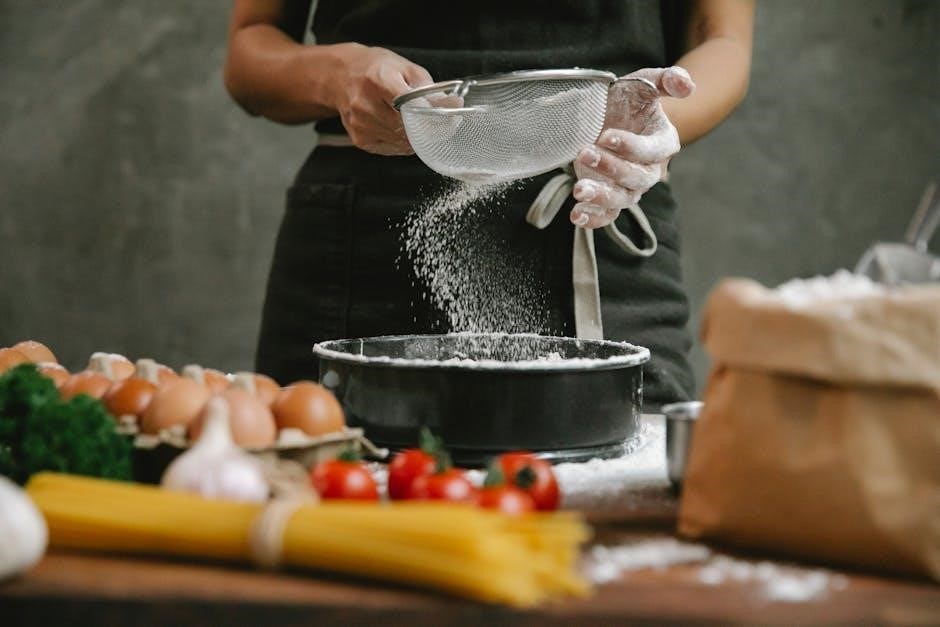
Stuffed pasta shapes, such as ravioli, agnolotti, and tortellini, are beloved for their rich fillings. Ravioli, typically filled with cheese or herbs, is a classic. Agnolotti del Plin, from Piedmont, is filled with roasted meat and served with butter. Tortellini, traditionally stuffed with pork and cheese, is often enjoyed in broth or with cream sauce. These shapes showcase Italy’s creativity, offering a delicious blend of flavors and textures in each bite.
Regional Pasta Specialties
Italian pasta varies richly by region, with unique shapes and dishes reflecting local traditions; Northern Italy favors hearty stuffed pastas, while Southern Italy celebrates simple, flavorful pairings with fresh ingredients.
Northern Italy Pasta Dishes
Northern Italy boasts a rich array of pasta dishes, often featuring hearty, rich flavors. Iconic dishes include Ravioli di Zucca (squash-filled ravioli with sage and butter) and Pizzoccheri (buckwheat pasta with cabbage and potatoes). Agnolotti del Plin (stuffed pasta with meat or vegetables) and Trofie (twisted pasta with pesto) are also highlights. These dishes reflect the region’s emphasis on local ingredients like cheese, butter, and cured meats, creating robust, flavorful profiles.
Central Italy Pasta Dishes
Central Italy’s pasta dishes are defined by simplicity and fresh flavors. Iconic options include Tagliatelle al Ragù from Emilia-Romagna, featuring flat pasta in a rich meat sauce, and Pappardelle al Cinghiale from Tuscany, with wide noodles tossed in wild boar ragù. Umbria’s Strangozzi with truffle sauce highlights the region’s love for earthy flavors. These dishes emphasize local ingredients and hearty, balanced flavors, showcasing Central Italy’s culinary artistry.
Southern Italy Pasta Dishes
Southern Italy’s pasta dishes are vibrant and bold, reflecting the region’s love for fresh seafood, olive oil, and fiery flavors. Classics like Spaghetti alle Vongole (spaghetti with clams) and Paccheri al Pomodoro (tubular pasta in tomato sauce) showcase the Mediterranean diet. Orecchiette con Cime di Rapa from Puglia combines ear-shaped pasta with bitter greens, while ‘Nduja-infused pasta from Calabria adds a spicy twist. These dishes highlight Southern Italy’s rich culinary heritage and its emphasis on seasonal ingredients.

Pasta Sauces and Pairings
Pasta sauces and pairings are the heart of Italian cuisine, blending simplicity with flavor. From classic tomato-based sauces to rich cream and vibrant pesto, each complements specific pasta shapes, creating harmonious dishes that celebrate Italy’s culinary diversity and regional traditions.
Tomato-Based Sauces
Tomato-based sauces are a cornerstone of Italian cuisine, offering simplicity and robust flavor. From classic Arrabbiata to rich Sicilian-style, these sauces pair perfectly with long pasta like spaghetti or short shapes like penne. Fresh tomatoes, herbs, and olive oil create a vibrant base, while variations like marinara or ragù add depth. Their versatility complements a wide range of pasta types, making them a timeless choice for authentic Italian dishes.
Cream-Based Sauces
Cream-based sauces add a rich, velvety texture to pasta dishes, often featuring ingredients like Parmesan, butter, and heavy cream. Classic options include Alfredo and Carbonara, which pair beautifully with smooth or ridged pasta shapes. These sauces enhance the pasta’s flavor while providing a luxurious, indulgent touch to meals. Their versatility allows for creative variations, making them a popular choice for both traditional and modern Italian recipes.
Pesto and Other Specialty Sauces
Pesto, a vibrant and flavorful sauce, is a quintessential Italian specialty, originating from Liguria. Made with fresh basil, garlic, pine nuts, Parmesan, and olive oil, it adds a bright, herby note to dishes. Often paired with long, thin pasta like spaghetti or linguine, pesto celebrates the simplicity of seasonal ingredients. Other specialty sauces, such as those featuring sun-dried tomatoes or spring vegetables, offer unique twists, enhancing pasta with bold, aromatic flavors and textures.
Cooking Techniques
Mastery of Italian pasta cooking involves perfecting boiling techniques and exploring alternative methods, ensuring al dente texture while preserving freshness and flavor in every dish.
Boiling Pasta to Perfection
Boiling pasta to perfection requires attention to detail. Start by filling a large pot with ample salted water and bringing it to a rolling boil. Add pasta, stir gently to prevent sticking, and cook until al dente. Timing varies by shape, so refer to package instructions. Reserve a cup of pasta water before draining, as it enhances sauce adherence. Drain thoroughly and serve immediately for optimal texture and flavor.
Alternative Cooking Methods
Beyond boiling, pasta can be baked, grilled, or stir-fried for unique textures. Baked ziti and lasagna showcase pasta in the oven with rich sauces. Grilling adds a smoky flavor, while stir-frying offers a quick, Asian-inspired twist. One-pot pasta dishes simplify preparation, cooking pasta and sauce together. These methods enhance creativity, allowing pasta to shine in diverse culinary contexts while retaining its signature texture and flavor.
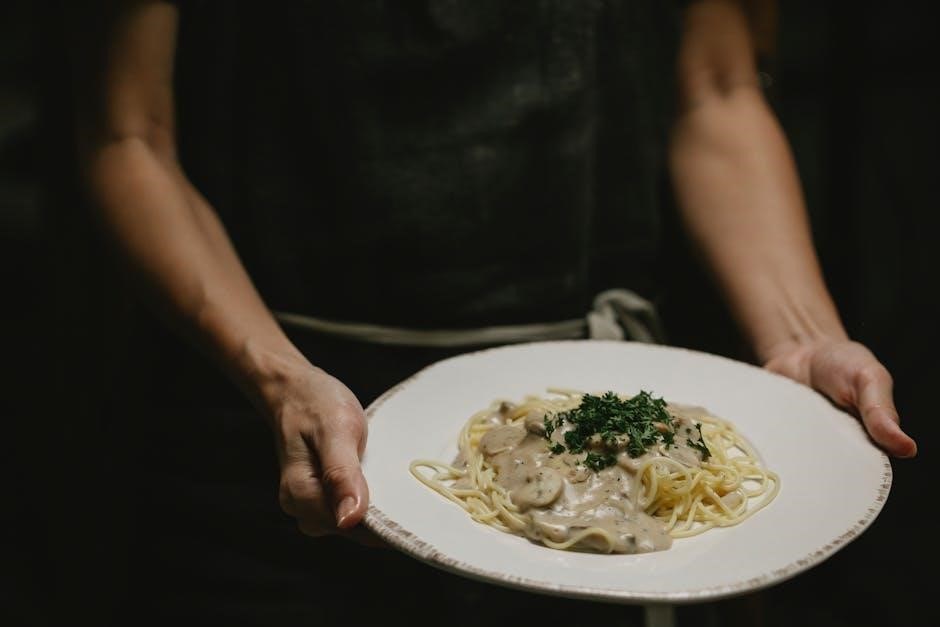
Homemade Pasta
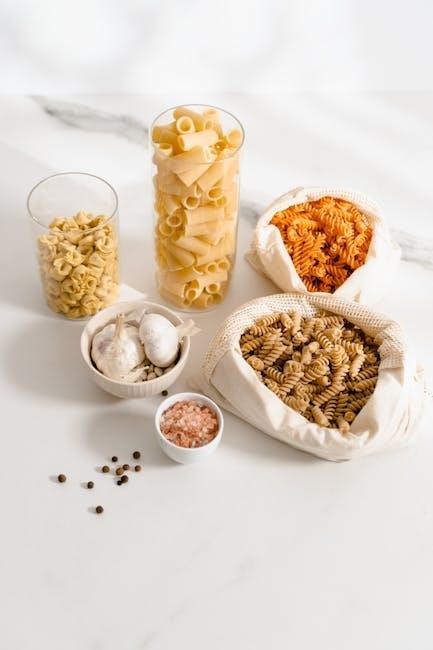
Homemade pasta embodies the essence of Italian tradition, offering a hands-on culinary experience. Simple ingredients like flour and eggs create a foundation for countless shapes and dishes.

Making Fresh Pasta Dough
Making fresh pasta dough is a simple yet rewarding process. Combine “00” flour and eggs to create a smooth, elastic dough. Knead for about 10 minutes until shiny and firm. Rest the dough for 30 minutes to relax gluten. Roll it out thinly using a pasta machine or a rolling pin. This traditional method ensures a delicate texture, perfect for shaping into various pasta forms like fettuccine or pappardelle.
Shaping Homemade Pasta
Shaping homemade pasta brings creativity to your dish. Using a pasta machine, roll dough to desired thinness, then cut into shapes like spaghetti or fettuccine. For hand-cut options, slice into strips for pappardelle or tagliatelle. Stuffed shapes like ravioli or tortellini require molds or folding techniques. Uniform thickness ensures even cooking. Each shape pairs perfectly with specific sauces, making homemade pasta a delightful culinary experience that showcases Italian tradition and personal flair.
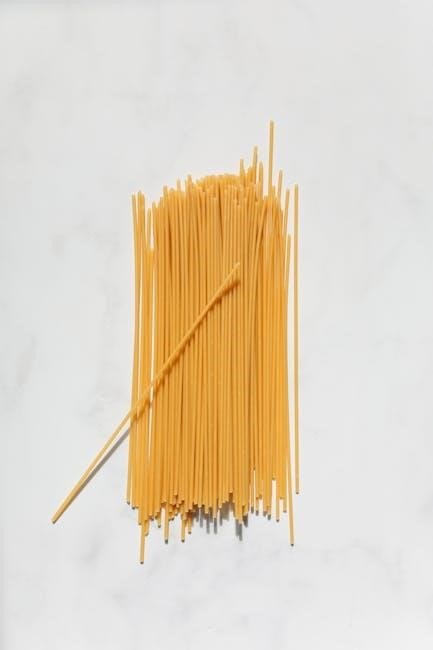
Dietary Considerations
Italian pasta adapts to diverse dietary needs, offering gluten-free and vegan options. These alternatives ensure everyone can enjoy authentic Italian flavors without compromising on taste or tradition.
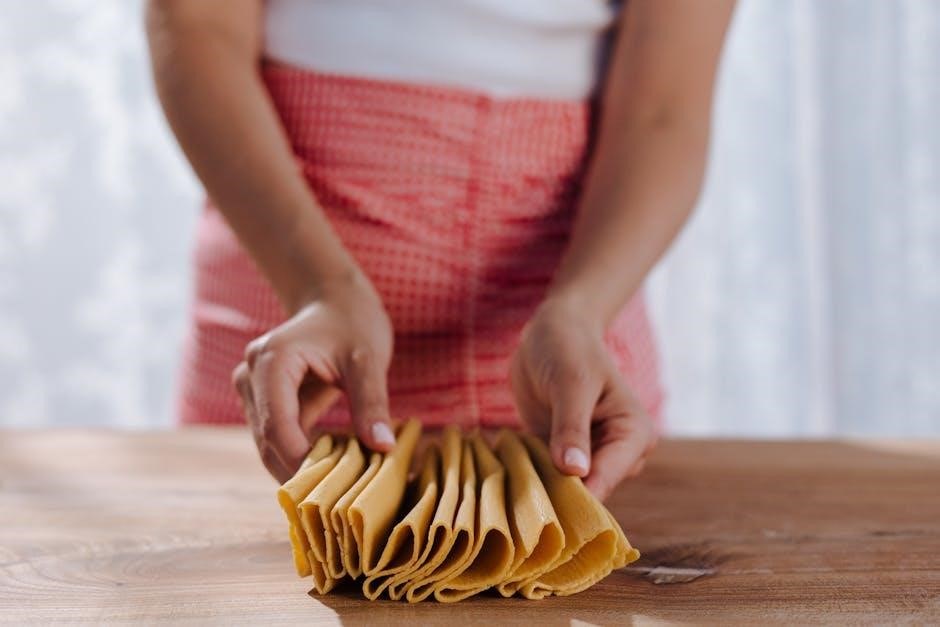
Gluten-Free Pasta Options
Gluten-free pasta offers a delicious alternative for those with dietary restrictions; Made from ingredients like rice, corn, or quinoa, these options maintain the taste and texture of traditional pasta while catering to gluten intolerance. Many brands now provide high-quality, gluten-free varieties, ensuring that everyone can enjoy authentic Italian dishes without compromise. This innovation allows for inclusive dining experiences, preserving the rich flavors of Italy for all to savor.
Vegan Pasta Recipes
Vegan pasta recipes are vibrant and flavorful, showcasing Italy’s culinary creativity. Dishes like sun-dried tomato pesto pasta highlight plant-based ingredients, combining tangy tomatoes, garlic, and fresh herbs. These recipes are free from meat and dairy, offering a delicious alternative for those with dietary preferences. Perfect for quick, satisfying meals, vegan pasta dishes bring the essence of Italy to your table, proving that tradition and innovation can coexist beautifully.
Italian pasta is a testament to the country’s rich culinary heritage, offering countless possibilities for every taste. From classic shapes to regional specialties, each dish tells a story of tradition and creativity. Whether exploring long, short, or stuffed varieties, pasta remains a beloved and versatile staple, allowing chefs and home cooks alike to craft unforgettable meals that celebrate Italy’s passion for food and culture.